Environmental Encyclopedia
Подождите немного. Документ загружается.

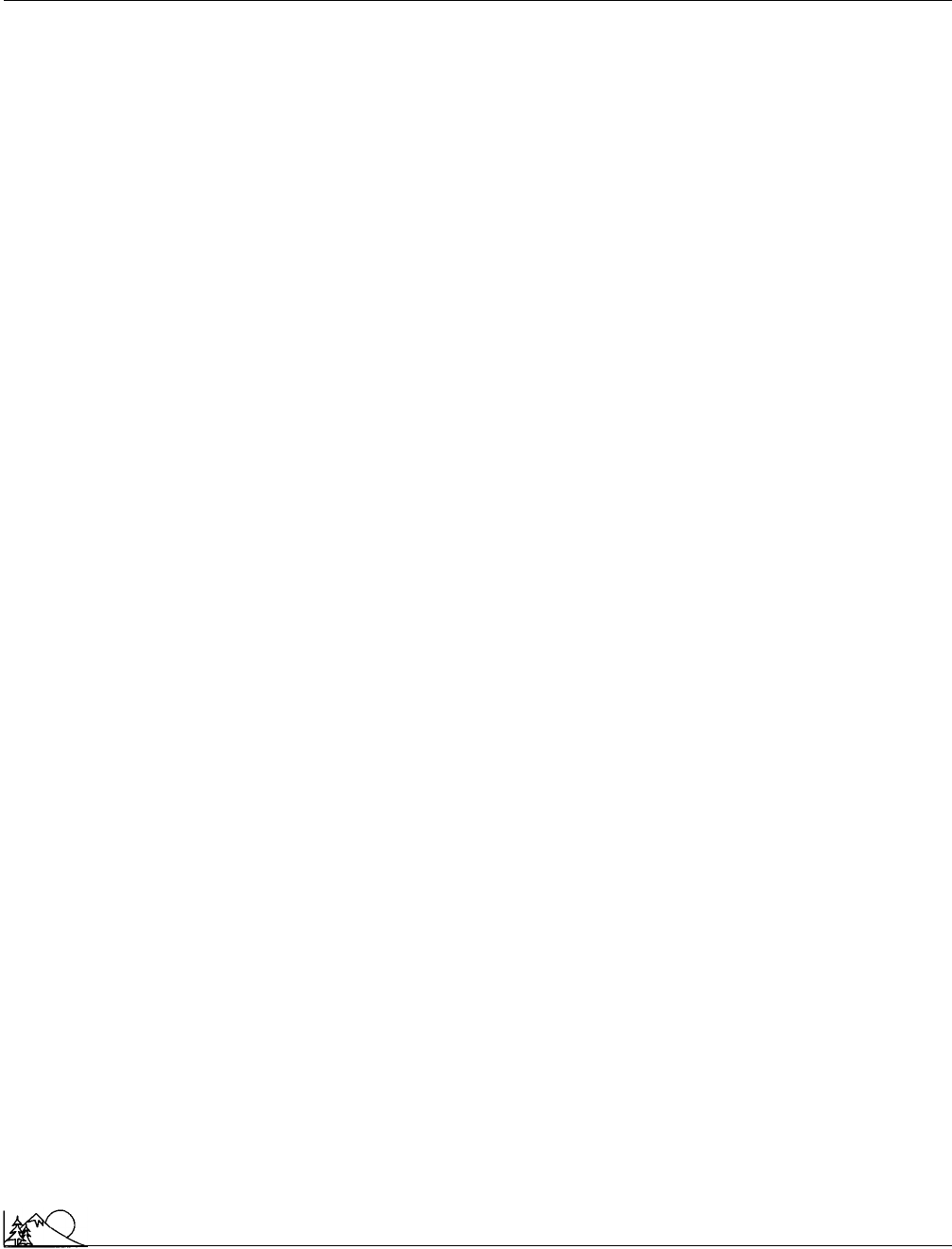
Environmental Encyclopedia 3
Ocean dumping
cluder devices (TEDs) on shrimp nets to help protect thou-
sands of endangered sea turtles. Turtles have also benefited
from the Ocean Conservatory’s research in artificial lighting.
The group convinced counties and cities throughout Florida
to control the use of artificial light on the state’s beaches
after proving that it prevents turtles from nesting and lures
baby turtles away from their natural habitat.
In 1988 the Ocean Conservatory established a database
on marine debris and, subsequently, the group created two
Marine Debris Information offices, one in Washington,
D.C. and one in San Francisco. These offices provide infor-
mation on marine debris, especially
plastics
, to scientists,
policy makers, teachers, students, and the general public.
While many of the Ocean Conservatory’s projects are exem-
plary, one has received so much attention that it has been
used as a model by other environmental groups, including the
Environmental Protection Agency
(EPA). The California
Marine Debris Action Plan, which went into effect in 1994,
is a comprehensive strategy for combating marine debris,
and a collaborative effort of the Ocean Conservatory and a
wide network of public and private organizations. In 2000
President Clinton enacted the Oceans Act which set up an
Oceans Commission to review and revise all policies dealing
with the protection of the ocean and the coast. The most
recent win for the Ocean Conservatory came in 2001, when
Tortugus (200 square nautical miles) was established as the
largest no-take marine reserve near Key West, Florida.
[Cathy M. Falk]
R
ESOURCES
O
RGANIZATIONS
The Ocean Conservancy, 1725 DeSales Street, Suite 600, Washington,
D.C. USA 20036 (202) 429-5609, Email: info@oceanconservancy.org,
<http://www.oceanconservancy.org>
Ocean dumping
Ocean dumping is internationally defined as “any deliberate
disposal at sea of wastes or other matter from vessels, aircraft,
platforms, or other man-made structures at sea, and any
deliberate disposal at sea of vessels, aircraft, platforms, or
other man-made structures at sea.” The
discharge
of sewage
and other effluents from a pipeline and the discharge of
waste incidental to, or derived from the normal operations
of, ships are not considered ocean dumping. Wastes have
been dumped into the ocean for thousands of years. Fish
and fish processing wastes, rubbish, industrial wastes, sewage
sludge
, dredged material,
radioactive waste
, pharmaceu-
tical wastes, drilling fluids, munitions,
coal
wastes, cryolite,
ocean
incineration
wastes, and wastes from ocean mining
have all been dumped at sea. Ocean dumping has historically
1007
been more economically attractive, when compared with
other land-based
waste management
options.
The 1972
Convention on the Prevention of Marine
Pollution by Dumping of Wastes and Other Matter
, com-
monly called the London Convention, came into force in
1975 to control ocean dumping activities. The framework
of the London Convention includes a black list of materials
that may not be dumped at sea under any circumstances
(including radioactive and industrial wastes), a grey list of
materials considered less harmful that may be dumped after
a special permit is obtained, and criteria that countries must
consider before issuing an ocean dumping permit. These
criteria require the consideration of the effects dumping
activities can have on marine life, amenities, and other uses
of the ocean, and encompass factors related to disposal opera-
tions, waste characteristics, attributes of the site, and avail-
ability of land-based alternatives. Most ocean dumping per-
mits (90–85%) reported by parties to the London
Convention are for dredged material. Currently only three
parties to the London Convention dump sewage sludge at
sea. Other categories of wastes that are permitted for ocean
dumping include inert, geological materials, vessels, and fish
wastes. The International Maritime Organization is respon-
sible for administrative activities related to the London Con-
vention, and it facilitates cooperation among the countries
party to the Convention. As of 2001, 78 countries had rati-
fied the Convention.
In the early 1990s, the parties to the London Conven-
tion began a comprehensive review of the treaty. This re-
sulted in the adoption of the 1996 Protocol to the London
Convention. The purpose of the Protocol is similar to that
of the Convention, but the Protocol is more restrictive:
application of a “precautionary approach” is included as a
general obligation; a “reverse list” approach is adopted; incin-
eration of wastes at sea is prohibited; and export of wastes for
the purpose of dumping or incineration at sea is prohibited.
Under the reverse list approach, dumping is prohibited unless
explicitly permitted, and only seven categories of materials
may be considered for dumping: dredge material; sewage
sludge; fish waste; vessels and platforms; inert, inorganic
geological material; organic material of natural origin; and
bulky items of unharmful materials when produced at loca-
tions with no other disposal options. The Protocol will enter
into force after 26 states ratify it (15 of which are party to
the London Convention). So far, 16 countries have ratified
it (13 of which are party to the London Convention).
Ocean dumping has been used as a method for munici-
pal waste disposal in the United States for about 80 years,
and even longer for dredged material. The law to regulate
ocean dumping in the United States is the Marine Protec-
tion, Research, and Sanctuaries Act of 1972. This Act, also
known as the Ocean Dumping Act, banned the disposal of
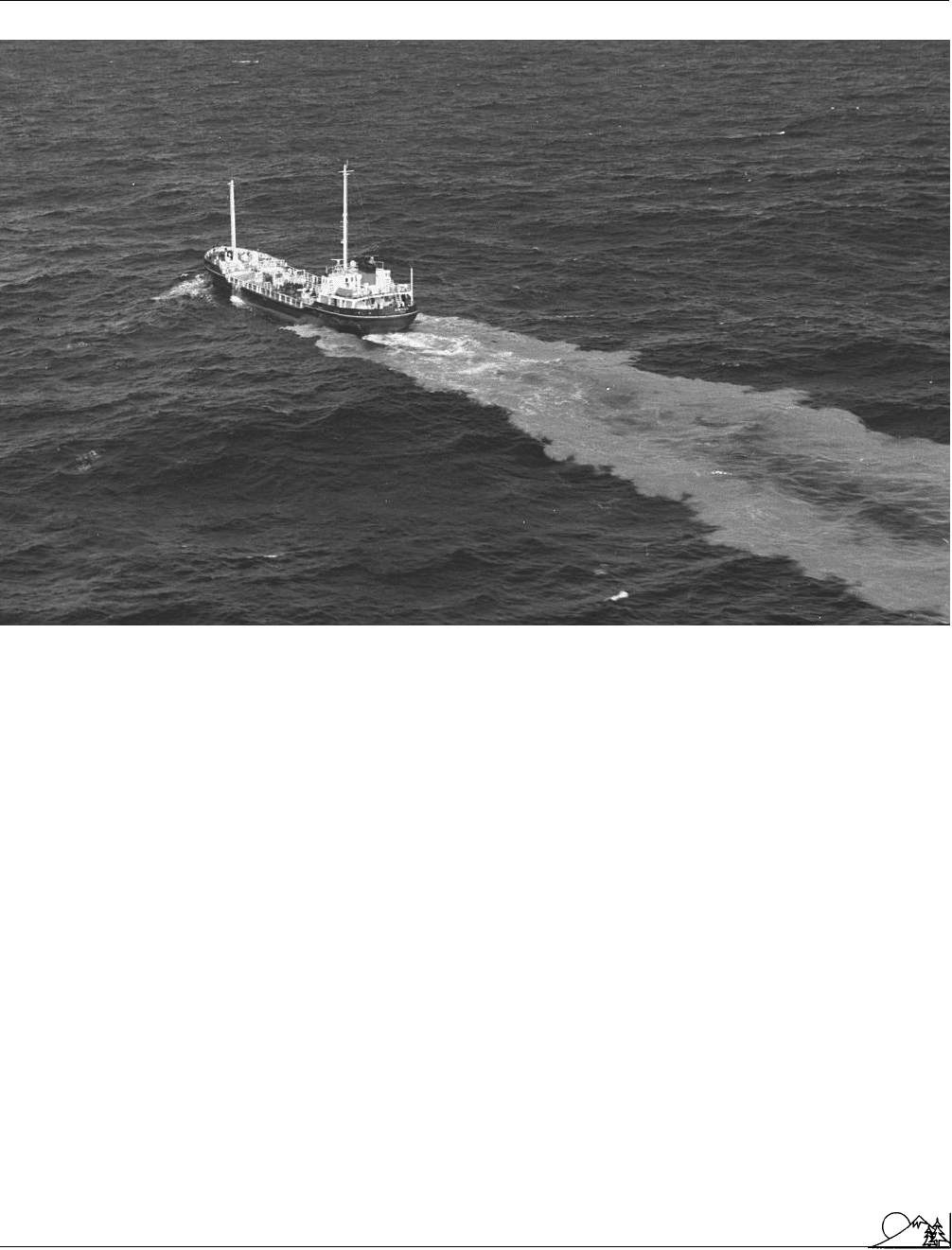
Environmental Encyclopedia 3
Ocean dumping
A ship dumping jarosite waste into the ocean off the Australia coast. (Photograph by Hewetson. Greenpeace. Reproduced
by permission.)
radiological, chemical, and biological warfare agents, high-
level radioactive waste, and medial waste. It requires a permit
for the ocean dumping of any other materials. Such a permit
can only be issued where it is determined that the dumping
will not unreasonably degrade or endanger human health,
welfare, or amenities, or the marine environment, ecological
systems, or economic potentialities. Furthermore, all permits
require notice and opportunity for public comment. EPA
was directed to establish criteria for reviewing and evaluating
ocean dumping permit applications that consider the effect
of, and need for, the dumping. The Ocean Dumping Act
has been revised by the United States Congress in the years
since its enactment. In 1974, Congress amended this Act
to conform with the London Convention. In 1977, the Act
was amended to incorporate a ban by 1982 on ocean dump-
ing of wastes that may unreasonably degrade the marine
environment
. As a result of this ban, approximately 150
permittees dumping sewage sludge and industrial waste
stopped ocean dumping of these materials. In 1983, the law
was amended to make any dumping of low-level radioactive
waste require specific approval by Congress. In 1988, the
1008
Ocean Dumping Ban Act
was passed to prohibit ocean
dumping of all sewage sludge and industrial waste by 1992.
Virtually all material ocean dumped in the United States
today is dredged material. Other materials include fish
wastes, human remains, and vessels.
Physical properties of wastes, such as density, and
its chemical composition affect the dispersal, and settling
of the wastes dumped at sea. Many contaminants such
as metals found in trace amounts in natural materials are
enriched in wastes. After material is dumped at sea, there
is usually initial, rapid dispersion of the waste. For example,
some wastes are dumped from a moving vessel, with
dilution rates of 1,000 to 100,000 from the ship’s wake.
As the wake subsides, naturally occurring turbulence and
currents further disperse wastes eventually to nondetectable
background levels in water in a matter of hours to days,
depending on the type of wastes and physical oceanic
processes. Dilution is greater if the material is released
slower and in smaller amounts, with dispersal rates decreas-
ing over time. Wastes, such as dredged material, that are
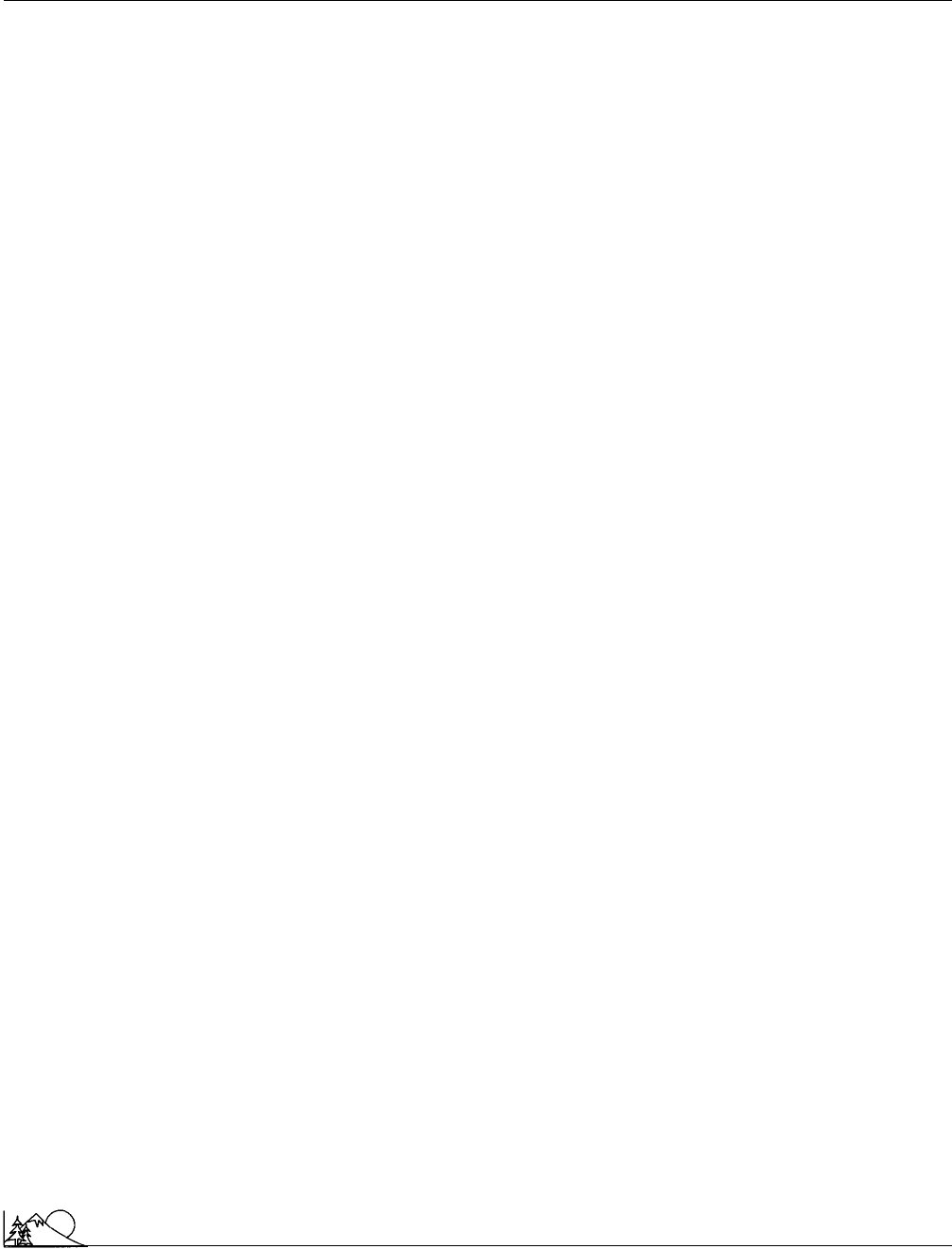
Environmental Encyclopedia 3
Ocean Dumping Ban Act (1988)
much denser than the surrounding seawater sink rapidly.
Less dense waste sinks more slowly, depending on the
type of waste and physical processes of the dumpsite. As
sinking waste particles reach seawater of equal density,
they begin to spread horizontally, with individual particles
slowly settling to the sea bottom. The accumulation of
the waste on the sea floor varies with the location and
characteristics of the dumpsite. Quiescent waters with little
tidal and wave action in enclosed shallow environments
have more waste accumulate on the bottom in the general
vicinity of the dumpsite. Wastes dumped in more open,
well-mixed ocean waters are transported away from the
dumpsite by currents and can disperse over a very large
area, as much as several hundred square kilometers.
The physical and chemical properties of wastes change
after the material has been dumped into the ocean. As wastes
mix with seawater, acid-base neutralization, dissolution or
precipitation of waste solids, particle
adsorption
and de-
sorption, volatilization at the sea surface, and changes in the
oxidation state may occur. For example, when acid-iron
waste is dumped at sea, the buffering capacity of seawater
rapidly neutralizes the waste. Hydrous iron oxide precipitates
are formed as the iron reacts with seawater and changes
from a dissolved to a solid form.
The fraction of the waste that settles to the bottom
is further changed as it undergoes geochemical and biological
processes. Some of the elements of the waste may be mobi-
lized in organic-rich
sediment
; however, if sulfide ions are
present, metals in waste may be immobilized by precipitation
of metal sulfides. Organisms living on the sea floor may
ingest waste particles, or mix waste deeper in the sediment by
burrowing activities.
Microorganisms
decompose
organic
waste
, potentially
recycling
elements from the waste before
it becomes part of the sea floor sediments. Generally sedi-
ment-related processes will act on waste particles over a
longer time scale than hydrologic processes in the water
column.
The effects of dumping on the ocean are difficult
to measure and depend on complex interactions of factors
including type, quantity, and physical and chemical proper-
ties of the wastes; method and rate of dumping; toxicity to
the
biotic community
; and numerous site-specific charac-
teristics, such as water depth, currents (turbulence), water
column density structure, and sediment type. Many studies
have found that the effects of ocean dumping on the water
column are usually temporary and that the ocean floor re-
ceives the most impact. Impacts from dumping dredged
material are usually limited to the dumpsite. Burial of some
benthic organisms (organisms living at or near the sea floor)
may occur; however, burrowing organisms may be able to
move vertically through the deposited material and fishes
typically leave the area. Seagrasses, coral reefs, and oyster
1009
beds may never recover after dredged material is dumped
on them. There also can be topographic changes to the sea
floor. See also Dredging
[Marci L. Bortman Ph.D.]
R
ESOURCES
O
THER
ArmyCorps of Engineers Ocean Disposal Database. [cited July 2002]. <http://
ered1.wes.army.mil/ODD>.
“EPA’s Ocean Dumping and Dredged Material Management.” EPA Web
Site. July 16, 2002 [cited July 2002]. <http://www.epa.gov/owow/oceans/
regulatory/dumpdredged/dumpdredged.html>.
London Convention. [cited July 2002]. <http://www.londonconventi-
on.org>.
Ocean dumping act
see
Marine Protection, Research and
Sanctuaries Act (1972)
Ocean Dumping Ban Act (1988)
The Ocean Dumping Ban Act of 1988 (Public Law 100-
688) marked an end to almost a century of sewage
sludge
and industrial waste dumping into the ocean. The law was
enacted amid negative publicity about beach closures from
high levels of pathogens and
floatable debris
washing up
along New York and New Jersey beaches and strong public
sentiment that ending ocean dumping may improve coastal
water quality
. The Ban Act prohibits sewage sludge and
industrial wastes from being dumped at sea after December
31, 1991. This law is an amendment to the Marine Protec-
tion, Research, and Sanctuaries Act of 1972 (Public Law
92-532), which regulates the dumping of wastes into ocean
waters. These laws do not cover wastes that are discharged
from outfall pipes such as from
sewage treatment
plants
or industrial facilities or that are generated by vessels.
The Ocean Dumping Ban Act was not the first at-
tempt to prohibit dumping of sewage sludge and industrial
wastes at sea. An earlier ban was developed by the U. S.
Environmental Protection Agency
(EPA) and later passed
by the U.S. Congress (Public Law 95-153) in 1977, amend-
ing the 1972 act. This 1977 law prohibits ocean dumping
that “may unreasonably degrade the marine environment”
by December 31, 1981. Approximately 150 entities dumping
sewage sludge and industrial waste sought alternative dis-
posal options. However, New York City, and eight munici-
palities in New York and New Jersey filed a lawsuit against
the EPA objecting to the order to end their ocean dumping
practices. A Federal district court granted judgment in their
favor, allowing them to continue ocean dumping under a

Environmental Encyclopedia 3
Ocean farming
court order. The court held that the EPA must balance, on
a case-by-case basis, all relevant statutory criteria with the
economics of ocean dumping against land-based alternatives.
After 1981, the New York and New Jersey entities were the
only dumpers of sewage sludge, and there were only two
companies dumping industrial waste at sea.
In anticipation of the 1988 Ocean Dumping Ban Act,
one of the two industries stopped its dumping activities in
1987. The remaining industry, which was dumping hydro-
chloric
acid
waste, also ceased its activities before the 1988
Ban Act became law. The entities from New Jersey and
New York continued to dump a total of approximately eight
million wet metric tonnes of sewage sludge (half from New
York City) annually into the ocean.
From 1924 to 1987, sludge dumpers used a site approx-
imately 12 miles (19 km) off the coasts of New Jersey and
New York. The EPA, working with the
National Oceanic
and Atmospheric Administration
(NOAA), determined
that ecological impacts such as shellfish bed closures, elevated
levels of metals in sediments, and introduction of human
pathogens into the marine
environment
were attributed
entirely or in part to sludge dumping at the 12 mile site. As
a result the EPA decided to phase out the use of this site
by December 31, 1987. The sewage sludge dumpers were
required to move their activities farther offshore to the 106-
mile (171-km) deep water dumpsite, located at the edge of
the continental shelf off southern New Jersey. Industries had
used this dumpsite from 1961 to 1987.
The Ocean Dumping Ban Act prohibits all dumping
of sewage sludge and industrial waste into the ocean, without
exception. The law also prohibits any new dumpers, and
required existing dumpers to obtain new permits that in-
cluded plans to phase-out sewage sludge dumping at sea.
The Ban Act also established ocean dumping fees and civil
fines for any dumpers that continue their activities after the
mandated end date. The fines were included in the law in
part because legislators assumed that some sludge dumpers
would not be able to meet the December 31, 1991 deadline.
The law required fees of $100 per dry ton of sewage sludge
or industrial waste in 1989, $150 per dry ton in 1990, and
$200 per dry ton in 1991. After the 1991 deadline penalties
rose to $600 per ton for any sludge dumped, and increased
incrementally in each subsequent year. Those ocean dumpers
that continue beyond December 31, 1991 are allowed to use
a portion of their penalties for developing and implementing
alternative sewage sludge management strategies. While the
amount of the penalty increased each year after 1991, the
amount that could be devoted to developing land-based
disposal alternatives decreased.
As part of the law, the EPA, in cooperation with
NOAA, is responsible for implementing an
environmental
monitoring
plan at the 12 mile site, the 106 mile site,
1010
and surrounding areas potentially influenced by dumping
activities to determine the effects of dumping on living ma-
rine resources. The Ban Act also includes provisions not
directly associated with dumping of sewage sludge or indus-
trial waste at sea. Massachusetts Bay-MA, Barataria Terreb-
onne Estuary Complex-LA, Indian River Lagoon-FL, and
Peconic Bay-NY were named as priority areas for consider-
ation to the
National Estuary Program
by EPA. The law
also includes a prohibition on the disposal of
medical waste
at sea by public vessels. Finally, the Ban Act requires vessels
transporting
solid waste
over the New York Harbor to the
Staten Island
Landfill
to use nets to secure the waste to
minimize the amount that may spill overboard.
The New Jersey dumpers ceased ocean dumping by
March 1991. The two New York counties stopped ocean
dumping by December 1991 and New York City, the last
entity to dump sewage sludge into the ocean, stopped zn
June 1992. Landfilling is currently used as an alternative
to ocean dumping and other sewage sludge management
strategies are under consideration including
incineration
(after the sludge is dewatered),
composting
, land applica-
tion, and pelletization. See also Convention on the Prevention
of Marine Pollution by Dumping of Waste and Other
Matter
[Marci L. Bortman Ph.D.]
R
ESOURCES
P
ERIODICALS
Kitsos, T. R., and J. M. Bondareff. “Congress and Waste Disposal at Sea.”
Oceanus 33 (Summer 1990): 23–28.
Millemann, B. “Wretched Refuse Off Our Shores.” Sierra 74 (January-
February 1989): 26–28.
“Ocean Dumping Ban Advances.” Journal of the Water Pollution Control
Federation 60 (August 1988): 1320+.
Weis, J. S. “Ocean Dumping Revisited.” BioScience 38 (December 1988):
749.
Ocean farming
Although oceans cover about 70% of the Earth’s surface,
most food is produced on land areas through agriculture
and animal husbandry. This is because 90% of the ocean is
unproductive. The productive areas are near shore, such as
continental shelfs,
upwellings
, coral reefs, mangrove
swamps (also known as mangal communities), and estuaries.
The primary reason why these near shore areas are more
productive than the open ocean is because of the supply of
nutrients which are needed for plant (primarily
phytoplank-
ton
) productivity, which fuels the
food chain/web
.
A worldwide plateau in harvesting of natural fish catch
was reached in about 1989, so commercial and sport fisheries
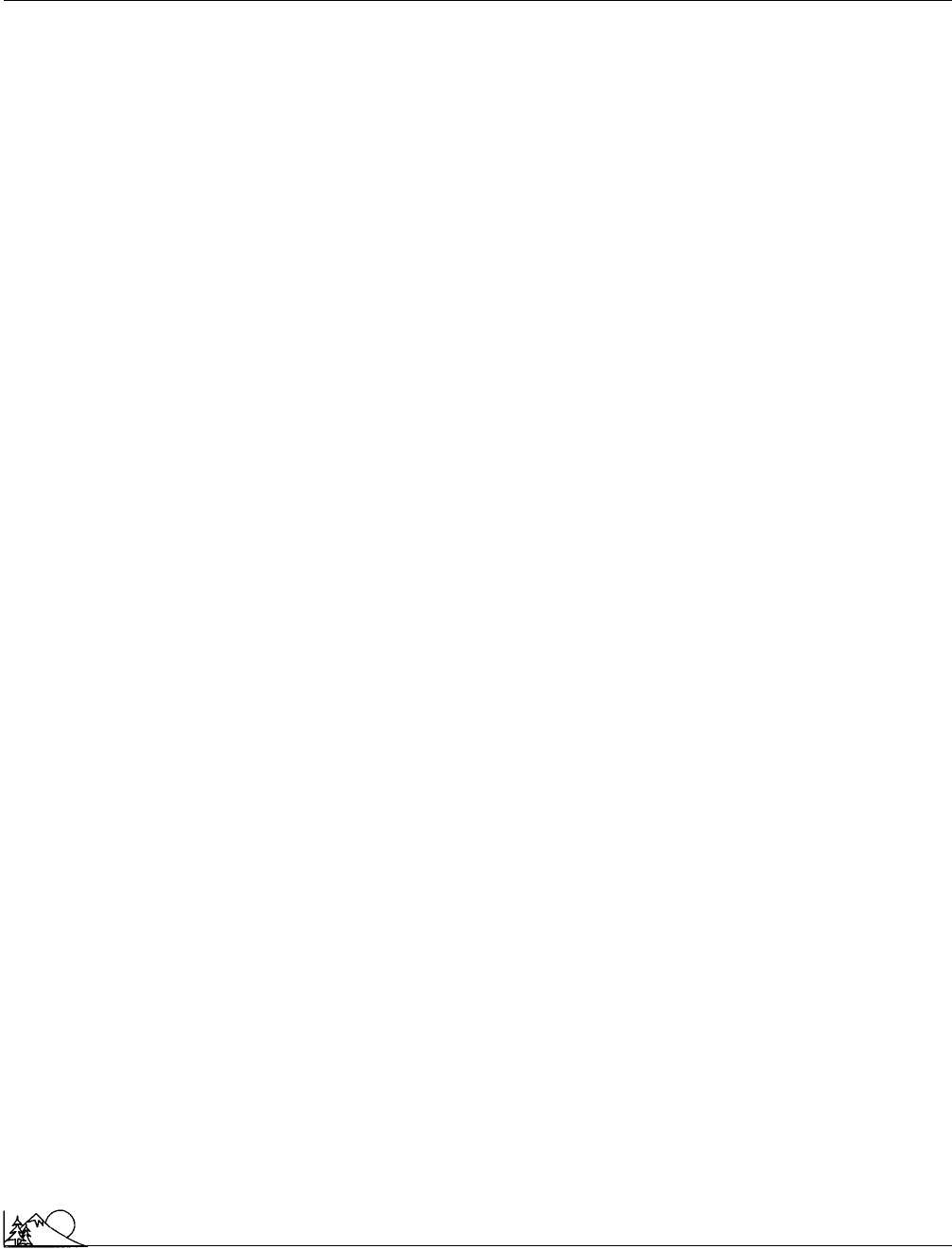
Environmental Encyclopedia 3
Ocean farming
in the oceans cannot be increased unless something is
changed. One possibility is to enhance production through
fertilization of the water. Another, more practical, possibility
is through
aquaculture
. As wild harvests decrease and per
capita seafood consumption increases, aquaculture should
have an important role. For example, the U.S. imports 60%
of its seafood, which contributes to its trade imbalance.
Aquaculture can help by providing jobs as well as food prod-
ucts for domestic consumption and for export.
Aquaculture done in seawater is known as
maricul-
ture
. Fish and shellfish are grown in improved conditions
to produce more and better food in environments with lower
predation and disease. There are several forms of aquacul-
ture: intensive, extensive, and open ocean. In extensive aqua-
culture, relatively little control is exerted by the mariculturist.
These typically occur near shore where organisms are grown
in several different ways: floating cages or pens; cordoned-
off bodies of water which can be fertilized for enhanced
production; or racks and other structures (to grow shellfish).
For example, oyster farmers in the
Chesapeake Bay
place
clean substrates in selected areas of the bottom mud each
summer to collect young oyster larvae (called “spat") as they
settle down from the
plankton
. These young oysters attach
and grow on the substrates, which are periodically transferred
to new locations to prevent them from being covered with
mud and
silt
. After several years, the oysters are large enough
to be marketed. Other culture methods for bivalves such as
oysters and clams utilize the stake method, which involves
the use of bamboo or other poles driven into the
sediment
and placed approximately 6 ft (2 m) apart. Nylon ropes
hanging from floats can also be used to collect larvae. Follow-
ing growout, the shellfish are collected and sold on the
market. Farmers in the Philippines are able to produce nearly
1.5 tons per acre (0.60 tons per ha) of mussels and 1.7
tons per acre (0.70 tons per ha) of oysters annually. These
techniques all have relatively low cost and maintenance.
Sometimes there are problems with
pollution
from domestic
and industrial waste, and periodic blooms of toxic dinoflagel-
lates (a type of phytoplankton), which create red tides. Red
tides can be unhealthy and even lethal to humans.
Intensive mariculture systems involve the production
of large quantities of marine animals in relatively small areas.
They are relatively expensive to build and maintain, so typi-
cally only highly-valued
species
are used, such as lobsters,
shrimp, halibut, and certain other fish. Intensive systems
can sometimes be located in tanks on land, using either
pumped salt water from the nearby ocean or recirculated
artificial seawater if the system is located farther away from
the ocean. Typically, however, nearshore or offshore floating
tanks or pens are used. The organisms are raised from eggs
to market size in these controlled environments.
Salmon
have been raised in sea pens (netted cages) for over 20 years
1011
along the Pacific coast of the United States and Canada
and along the Atlantic coasts of France, Scotland, and the
Scandinavian countries, especially Norway. This process typ-
ically involves the growth of salmon from fertilized eggs
through the fry stage in indoor fresh water hatcheries. This
is followed by the transfer of parr (the stage after the fry in
which the fish develop vertical lines along their sides) to
outdoor tanks or cages in salt water. The fish are fed either
commercial pellets or “trash” fish such as herring, capelin,
menhaden, and anchovies. The feeding process can be quite
labor-intensive, and thus translates into one of the highest
expenses for the salmon farmer. After one to two years, the
salmon go through a process called smoltification, which
involves a physiological change that allows them to live in
salt water. The smolt are then transferred to salt water cages
for another one to two years until they reach a market size
of about 4-12 lb (2-5 kg). Rainbow and sea trouts are handled
in a similar way, although they are usually larger when moved
into sea pens. As with the extensive method, problems can
arise through pollution and red tides.
Most mariculture industries use both nearshore and
offshore cages for raising the fish. The nearshore cages are
necessary for raising young fish, but the offshore cages are
better for raising fish to maturity because of enhanced grow-
ing conditions (cleaner water and lower
mortality
). Im-
provements are still needed, such as methods to remove dead
fish, make grading (sorting) of fish possible, make harvesting
easier and feeding possible (particularly during adverse
weather), and make fouling removal easier. It will also be
helpful to construct 24-hour living accommodations on some
of the larger offshore units.
A third form of mariculture is known as ocean ranch-
ing, or “enhancement aquaculture.” This can be compared
to cattle ranching on land. For example, salmon are raised
in hatcheries until they reach the smolt stage, and are then
released at a particular point along the shore where they
swim away until they reach reproductive maturity. Like other
anadromous fish, they return to that same area several years
later, where they are recaptured, processed, and sold on the
market. Salmon are ideal fish for this because they are “self-
herding.” However, normal returns range from only 1-20%,
depending upon the
water quality
of the return
environ-
ment
and the release size of the fish. For example, Coho
salmon fry that were around 0.5 oz (14 g) showed a 1-2%
return while those twice this size had a 7-8% return rate.
Recent research has shown that released salmon can be im-
printed to return to salt water sites, which has the added
advantages of lower cost (due to not needing more expensive
property located along streams that enter the ocean), and
better meat quality (which declines when salmon swim from
salt to fresh water). The Sea Run, Inc. salmon company of
Kennebunkport, Maine, rears Pacific pink and chum salmon
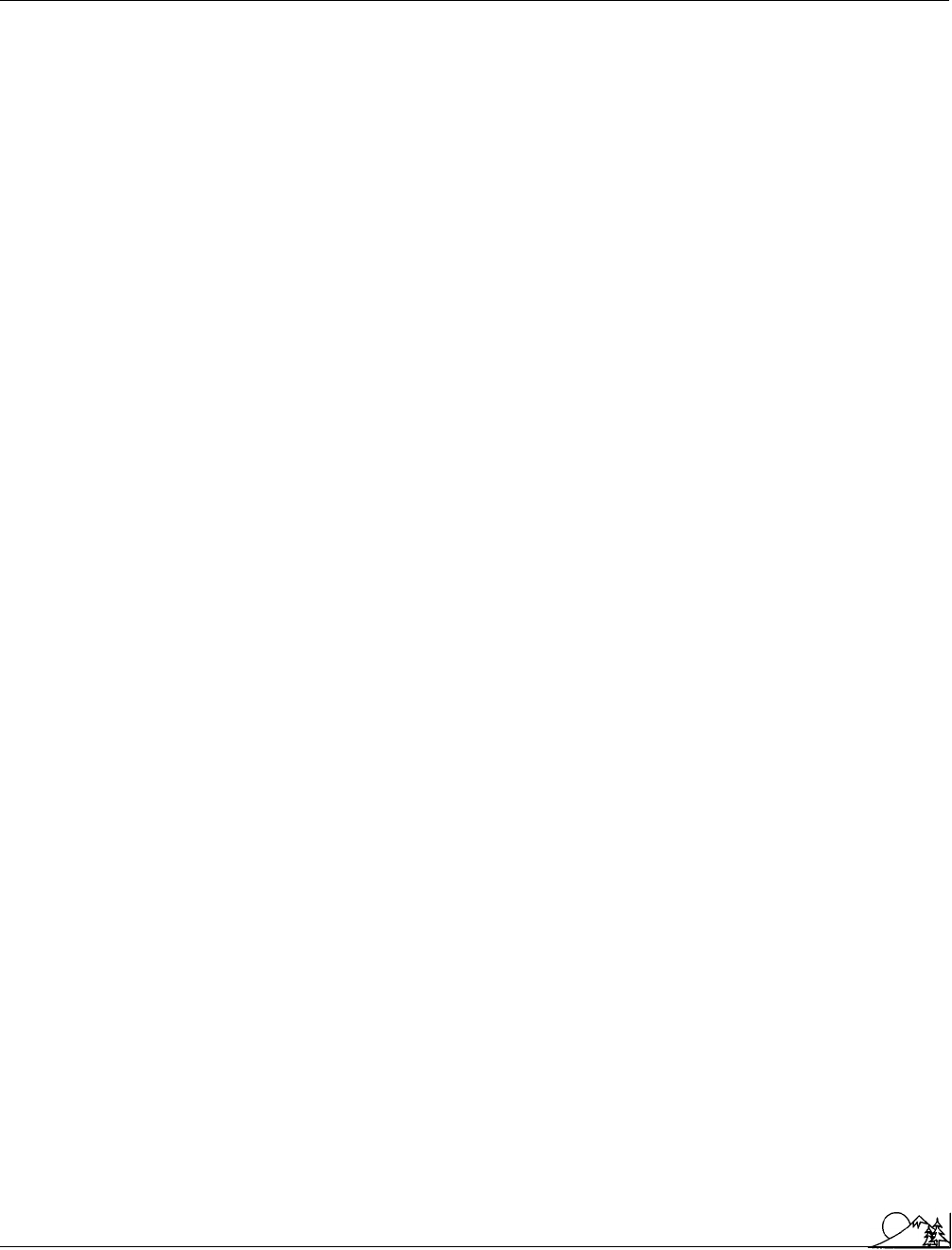
Environmental Encyclopedia 3
Ocean outfalls
from eggs to fingerlings in a hatchery located near the
dis-
charge
of an oil-fired power plant. The water has a charac-
teristic temperature and smell which attracts the salmon
back to the same area each year. They have also experimented
with the release of morpholine and phenyethyl alcohol (syn-
thetic organic compounds) to the water to aid in imprinting.
Similar ocean ranching techniques have been used in
other countries. For example, in Japan the natural catch of
Red Sea bream has declined for the last 24 years (more than
a 51% decrease) due to over-exploitation, so these fish have
been raised in tanks and cages since 1962. Other species
commonly raised in Japan include salmon, flounder, mack-
erel, bluefin tuna, shrimp, scallops, and abalone. Many of
these species have a high consumer demand and thus are
highly priced. Abalone can also be grown to a small size of
approximately 1 in (3 cm) and used to re-seed areas where
the natural population has declined. They can then be har-
vested as adults about three to five years later. However,
recapture rates are typically low (only 0.5–10%).
Ocean farming or ranching is becoming popular
worldwide. In Equador, Mazatlan Yellowtail fish are grown
to commercial size (2.7 lb; 1.2 kg) in six months with a 90%
survival rate. Other species raised in this country include
flounder, snook, red drum, and Pacific pompano. In
Austra-
lia
, oysters are commonly raised via sea ranching. Scallops
and salmon are now raised in Canada. Mussels, oysters,
clams, bream, turbot, and salmon are common mariculture
species in Spain, where the warm water allows these species
to be grown to market size in a shorter time.
Recent work has been done on algal turf mariculture
around some Caribbean islands in natural, unfertilized wa-
ters. Test plots have shown that they can raise up to 25
million tons (23 million metric tonnes) of dry algae per year
without harming the natural
ecosystem
. This product can
then be used for direct human ingestion or as food to raise
marine invertebrates (such as West Indian spider crabs,
conchs, and whelks) as well as some herbivorous fish. This
would be particularly helpful because conch are now an
endangered species
through over-harvesting in this area.
Ocean ranching, along with other forms of aquacul-
ture, is an exciting field that should be in greater demand
in the future. Our progeny may depend on it more for global
food production to feed the increasing human population.
[John Korstad]
R
ESOURCES
B
OOKS
Landau, M. Introduction to Aquaculture. New York: Wiley, 1992.
P
ERIODICALS
Adey, W. H. “Food Production in Low-Nutrient Seas.” BioScience 37
(1987): 340–8.
1012
Shelty, H. P. C., and G. P. Satyanarayana Rao. “Aquaculture in India.”
World Aquaculture 27 (1996): 20–24.
O
THER
Reinertsen, H., L.A. Dahle, L. Jørgensen, and K. Tvinnereim. Fish Farming
Technology. Proceedings of the First International Conference on Fish Farm-
ing Technology, Trondheim, Norway, August 9-12, 1993. Brookfield, VT:
Balkema Publishers, 1993.
Ocean outfalls
Pipelines extending into coastal and ocean waters that are
used by various industries and municipal
wastewater
treat-
ment facilities to
discharge
treated
effluent
. Some may be
simple pipes serving as conveyances from land-based facili-
ties; others include diffusers that help to rapidly dilute efflu-
ent or risers that ensure effluent is discharged at a certain
height above the ocean floor. The conveyances may extend
more than three miles (5 km) offshore, beyond coastal waters
into open ocean. Offshore oil and gas exploration, develop-
ment, and production rigs also possess ocean outfalls. Dis-
charges from these pipes must be permitted under the
Clean
Water Act national pollutant discharge elimination sys-
tem
. See also Sewage treatment
Ocean pollution
see
Marine pollution; Ocean dumping
Ocean thermal energy conversion
For many years, scientists have been aware of one enormous
reservoir
of energy on the earth’s surface: the oceans. As
sunlight falls on the oceans, its energy is absorbed by seawa-
ter. The oceans are in one sense, therefore, a huge “storage
tank” for
solar energy
. The practical problem is finding a
way to extract that energy and make it available for hu-
man use.
The mechanism suggested for capturing heat stored
in the ocean depends on a thermal gradient always present
in seawater. Upper levels of the ocean may be as much as
36°F (20°C) warmer than regions 0.6 mile (1 km) deeper.
The technology of ocean thermal energy conversion
(OTEC) takes advantage of this temperature gradient.
An OTEC plant would consist of a very large floating
platform with pipes at least 100 feet (30 m) in diameter
reaching to a depth of up to 0.6 mile (1 km). The “working
fluid” in such a plant would be ammonia, propane, or some
other liquid with a low boiling point.
Warm surface waters would be pumped into upper lev-
els of the plant, causing the working fluid to evaporate. As
the fluid evaporates, it will also exert increased pressure. That
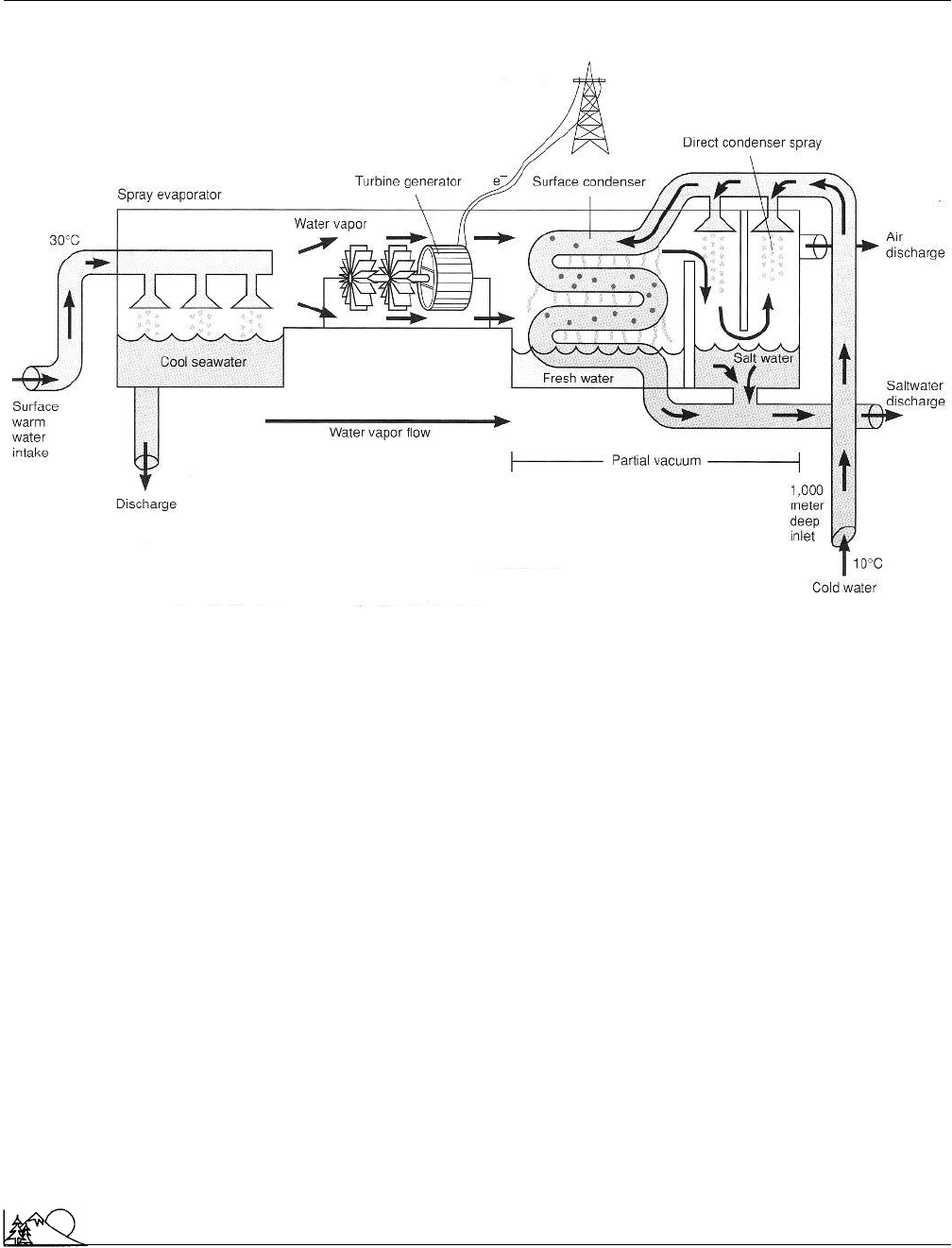
Environmental Encyclopedia 3
Ocean thermal energy conversion
The Open Cycle Ocean Thermal Electric Generator requires a water temperature differential of at least 36°F
(20° C) to produce both fresh water and electricity. (McGraw-Hill Inc. Reproduced by permission.)
pressure can be used to drive a turbine that, in turn, generates
electricity. The electricity could be carried to shore along large
cables or used directly on the OTEC plant to desalinize water,
electrolyze water, or produce other chemical changes.
In the second stage of operation, cold water from deeper
levels of the ocean would be brought to the surface and used
to cool the working fluid. Once liquified, the working fluid
would be ready for a second turn of the generating cycle.
OTEC plants are attractive alterative energy sources
in regions near the equator, where surface temperatures may
reach 77°F (25°C) or more. These parts of the ocean are
often adjacent to
less developed countries
, where energy
needs are growing.
Wherever they are located, OTEC plants have a num-
ber of advantages. For one thing, oceans cover nearly 70
percent of the planet’s surface so that the raw material OTEC
plants need—seawater—is readily available. The original en-
ergy source—sunlight—is also plentiful and free. Such plants
are also environmentally attractive since they produce no
pollution
and cause no disruption of land resources. Planners
suggest that a by-product of OTEC plants might be nutri-
1013
ents brought up from deeper ocean levels and used to feed
“farms” of fish or shellfish.
Unfortunately, many disadvantages exist also. The
most important is the enormous cost of building and main-
taining the mammoth structures needed for an OTEC plant.
Also, the temperature differential available under even the
best of conditions means that an OTEC plant will not be
more than about 3% efficient.
Currently, the disadvantages of OTEC plants are so
great that none has even been built. Research continues in
a number of countries, but some experts believe that the low
efficiency of OTEC means that this technology will never
be able to compete economically with other alternative
sources of energy. See also Desalinization; Energy efficiency;
Power plant; Thermal stratification (water)
[David E. Newton]
R
ESOURCES
P
ERIODICALS
Fisher, A. “Energy from the Sea.” Popular Science (June 1975): 78–83.
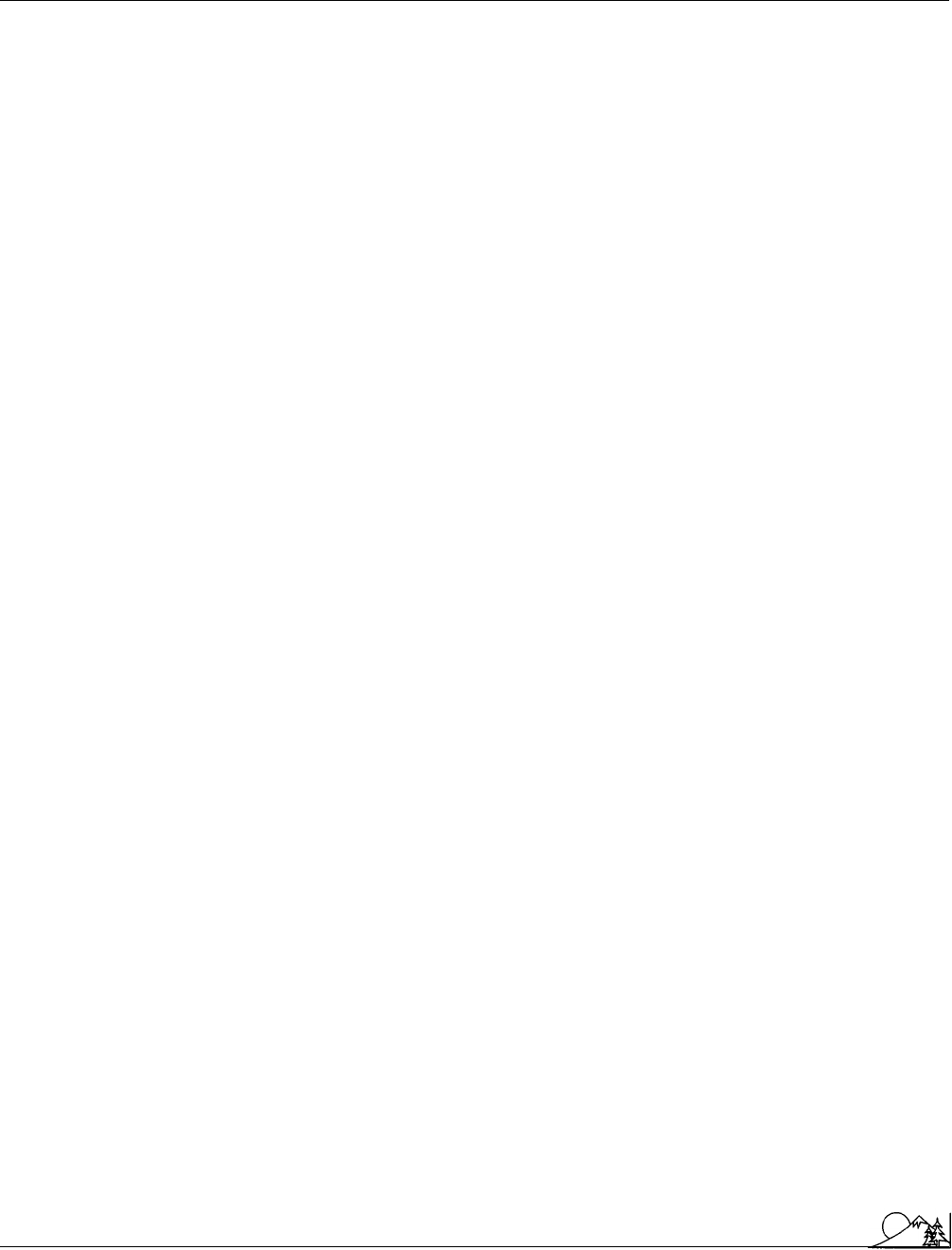
Environmental Encyclopedia 3
Octane rating
Haggin, J. “Ocean Thermal Energy Conversion Experiment Slated for
Hawaii.” Chemical & Engineering News (February 10, 1986): 24–26.
Penney, T. R., and D. Bharathan, “Power from the Sea.” Scientific American
256 (January 1987): 86–92.
Walters, S. “Power in the Year 2001, Part 2—Thermal Sea Power.” Mechan-
ical Engineering (October 1971): 21–25.
Whitmore, W. “OTEC: Electricity from the Ocean.” Technology Review
(October 1978): 58–63.
OCRWM
see
Office of Civilian Radioactive Waste
Management
Octane rating
Octane rating is a method for describing antiknock proper-
ties of
gasoline
. Knocking is a pinging sound produced by
internal
combustion
engines when fuel ignites prematurely
during the engine’s compression cycle. Because knocking
can damage an engine and rob it of power, gasoline formula-
tions have been developed to minimize the problem. Gaso-
lines containing relatively large amounts of straight-chain
hydrocarbons
(such as n-heptane) have an increased ten-
dency to knock, whereas those containing branched-chain
forms (such as isooctane) burn more smoothly. In addition
to isooctane, other compounds also reduce engine knocking.
By using an index called octane number, it is possible to
compare the antiknock properties of gasoline mixtures. A
higher octane number indicates that a mixture has the equiv-
alent antiknock properties of a gasoline containing a higher
percentage of isooctane.
Although gasoline used as automotive fuel is now “de-
leaded,” gasoline used as aviation fuel still contains
tetra-
ethyl lead
as an octane enhancer and antiknock agent.
Svante Ode
´
n
Swedish agricultural scientist
One of the great environmental issues of the 1970s and
1980s was the problem of
acid
precipitation. Research stud-
ies suggested that rain, snow, and other forms of precipita-
tion in certain parts of the world had become increasingly
acidic over the preceding century. The southern parts of
Scandinavia and England, the Northeastern United States,
and Eastern Canada were four regions in which the phenom-
enon was particularly noticeable.
Evidence began to accumulate that the increasing level
of acidity might be associated with environmental damage,
such as the death of trees and aquatic life. Scientists began
to ask how extensive this damage might be and what sources
of acid precipitation could be identified.
1014
If any single person could be credited with raising
international awareness of this problem, it would probably
be the Swedish agricultural scientist Svante Ode
´
n. Ode
´
n
was certainly not the first person to recognize the existence,
effects, or origins of acid precipitation. That honor belongs
to an English chemist,
Robert Angus Smith
. As early as
1852, Smith hypothesized a connection between
air pollu-
tion
in Manchester and the high acidity of rains falling in
the area. He first used the term
acid rain
in a book he
published in 1872.
Smith’s research held relatively little interest to most
scientists, however. Those who did study acid rain ap-
proached their work with little concern about the
environ-
ment
and did so, as one of them later said, “with no environ-
mental consciousness,” but simply because “it was an
interesting situation.”
Ode
´
n’s attitude was quite different. He had been asked
by the Swedish government to prepare a report on his hy-
pothesis that acid rain falling on Swedish land and lakes
had its origins hundreds or thousands of miles away. In
preparing his report, he came to the conclusion that acid
rain might be responsible for widespread
fish kills
then
being reported by Swedish fishermen. Ode
´
n was shocked
by this discovery because, as he later said, it was the “first
real indication that acid precipitation had an impact on the
biosystem.”
Ode
´
n’s method of dealing with his discoveries was
unorthodox. In most cases, a researcher sends the report of
his or her work to a scientific journal, which has the report
reviewed by other scientists in the same field. If the research
is judged to have been well done, the report is published.
In this instance, however, Ode
´
n sent his report to a
Stockholm newspaper, Dagens Nyheter, where it was pub-
lished on October 24, 1967. Ode
´
n’s decision undoubtedly
disturbed some scientists, but it did have the effect of bring-
ing the issue of acid rain to the attention of the general
public.
A year later, Ode
´
n published a more formal report of
his research, “The
Acidification
of Air and Precipitation,
and Its Consequences,” in the Ecology Committee Bulletin.
The article was later translated into English. Ode
´
n carried
his message about acid precipitation to the United States in
person in 1971, when he presented a series of 14 lectures
on the topic at various institutions across the country. In his
presentations, he argued that acid rain was an international
phenomenon that, in Europe, originated especially in En-
gland and Germany and was spreading over thousands of
miles to other parts of the continent, especially Scandinavia.
His work also laid the foundation for Sweden’s case study
for the
United Nations Conference on the Human Envi-
ronment
“Air
Pollution
Across National Boundaries” pre-
sented at Stockholm in 1972. He further suggested that a
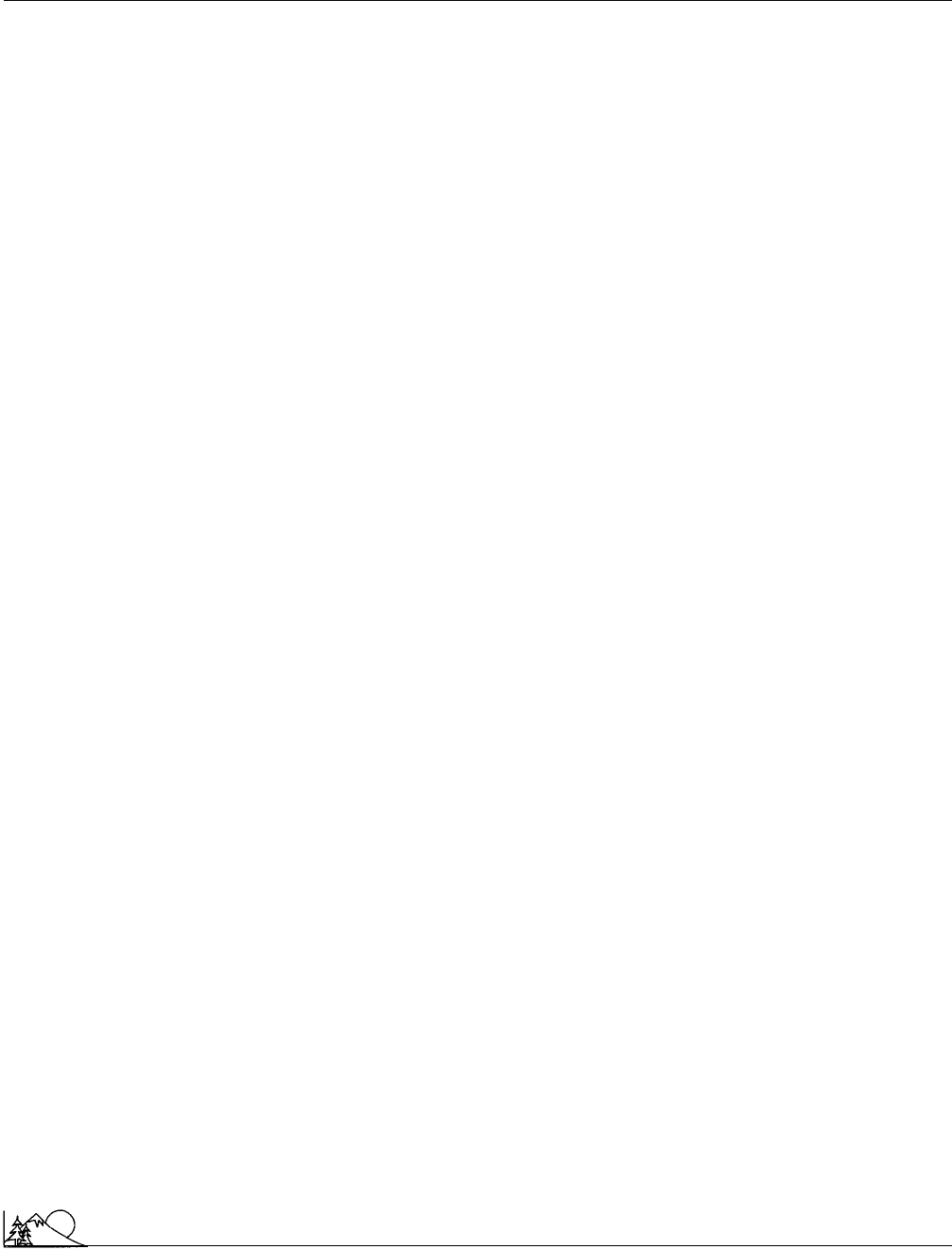
Environmental Encyclopedia 3
Dr. Eugene P. Odum
number of environmental effects, such as the death of trees
and fish and damage to buildings, could be traced to acid
precipitation. Ode
´
n’s passionate commitment to publicizing
his findings about acid precipitation was certainly a critical
factor in awakening the world’s awareness to the potential
problems of this environmental danger.
[David E. Newton]
R
ESOURCES
B
OOKS
Boyle, R. H., and R. A. Boyle. Acid Rain. New York: Nick Lyons
Books, 1983.
Luoma, J. Troubled Skies, Troubled Waters. New York: Viking Press, 1984.
Park, C. Acid Rain: Rhetoric and Reality. London: Methuen, 1987.
P
ERIODICALS
Cowling, E. B. “Acid Precipitation in Historical Perspective.” Environmen-
tal Science and Technology 16 (1982): 110A–123A.
Odor control
Refuse-handlers and many industries release unpleasant
odors into the air which can travel for miles. Odors inside
factories can also make it difficult for people to work, and
pollutants can impart a strong odor to water.
Odors can be released from
chemicals
, chemical reac-
tions, fires, or rotting material. The air carries odor-produc-
ing gas molecules, and they are detected by breathing or
sniffing. The molecules stimulate receptor cells in the nose,
which in turn send nerve impulses to the brain where they
are processed into information about the odor.
Research is being performed to quantify and character-
ize odors. Tests such as sniff
chromatography
,
emission
rate measurement, and hedonics are being used in an effort
to develop a better definition of what offensive odors are.
Scientists have found that the perception of odors is
highly subjective. What one person might not like, another
person might not be able to smell at all, and what people
define as an offensive odor depends on age and sex, as well
as other characteristics.
One method of controlling unpleasant smells is de-
odorizers. Deodorizers either disguise offensive odors with
an agreeable smell or destroy them. Some deodorizers do
this by chemically changing odor-producing particles while
others merely remove them from the air. Disinfectants, such
as formaldehyde, can kill bacteria,
fungi
or molds that create
odors. Odors can also be removed through ventilation sys-
tems. The air can be “scrubbed” by forcing it through liquid
or through
filters
containing such materials as charcoal,
methods which trap and remove odor-producing particles
from the air. Factories can also employ a process known as
1015
“re-odorization,” which works on the principle that there are
seven basic odor types: camphoraceous, mint, floral, musky,
ethereal, putrid, and pungent. The process is based on the
theory that different combinations of these odor types pro-
duce different smells, and re-odorization releases chemicals
into the air to combine with the regular factory odors and
generate a more pleasant smell.
Aeration
is one method of removing objectionable
odors from water. The surface of the water is mixed with
air and the oxygen oxidizes various materials that would
otherwise turn the water foul. Aeration can be accomplished
by running the water over steps or spraying the water through
nozzles. Trickling the water over trays of coke also helps
eliminate offensive odors, and adding activated charcoal can
have the same effect.
Even though science has shown that the perception
of odors is subjective, many people are offended by them.
It is often considered a quality-of-life issue, and politicians
have been strongly influenced by their constituencies. Nui-
sance regulations have been passed in many states and mu-
nicipalities, and though they often vary, their attempts to
distinguish between acceptable and unacceptable odors are
often vague and difficult to apply. Proving that odors inter-
fere with the quality of life is not only subjective but nearly
impossible. Refuse-handlers and factories are perhaps the
most adversely affected; they often receive heavy fines for
odors, although there is no proven method for eliminating
them. Many believe a more concrete system of regulations
is needed, but science has not been able to provide the basis
on which to build one. See also Noise pollution; Pollution
control
[Nikola Vrtis]
R
ESOURCES
B
OOKS
Bowker, P. G. Odor and Corrosion Control in Sanitary Sewerage Systems and
Treatment Plants. New York: Hemisphere, 1989.
Hesketh, H. E. Odor Control Including Hazardous-Toxic Odors. Lancaster,
PA: Technomic, 1988.
Kreis, R. D. Control of Animal Production Odors: The State-of-the-Art. Ada,
OK: U.S. Environmental Protection Agency, 1978.
P
ERIODICALS
Hunt, P., and K. Hauck. “Raising a Stink Over Composting Odors.”
American City and County 105 (December 1990): 64–65.
Dr. Eugene P. Odum (1913 – )
American ecologist
Eugene P. Odum has been called “the ecologist’s ecologist,”
meaning that he has been of special significance to his col-
leagues in the development of the discipline, and in formulat-
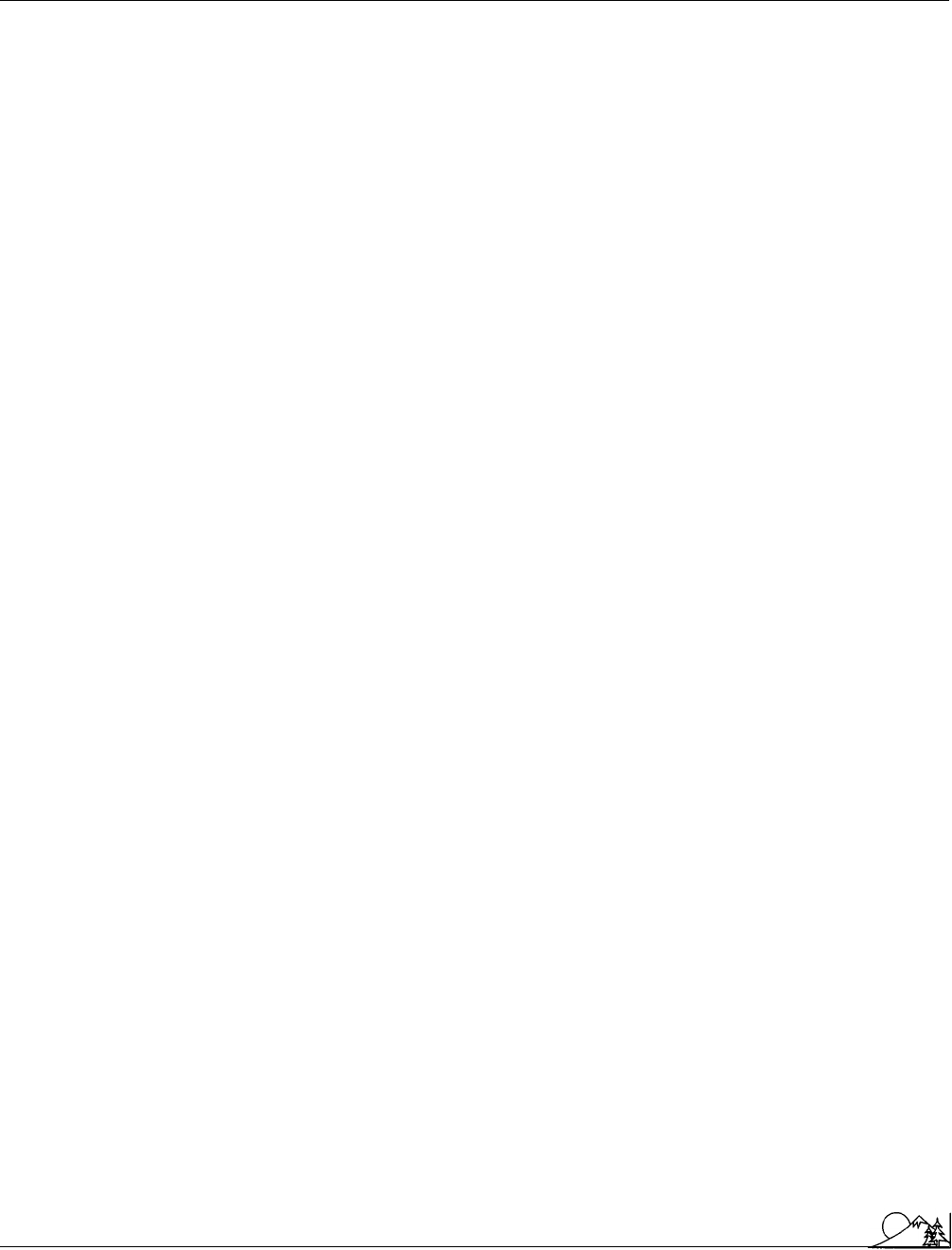
Environmental Encyclopedia 3
Office of Civilian Radioactive Waste Management
ing its content, outlines, and boundaries. He helped lay the
foundations for what might be called the “modern” study of
ecology
in the 1940s and 1950s by redirecting the field to
studies based on energetics, on the relatively new
ecosystem
concept, and on functional as well as structural analyses of
living communities. From early in his career, he has worked
to define general principles in ecology. His colleagues and
associates have recognized him by electing him president of
the
Ecological Society of America
, through election to the
National Academy of Sciences
, and through the awarding
of prestigious prizes, including the Tyler Award in 1977 and
the Crafoord Prize in 1987.
Odum was born in Lake Sunapee, New Hampshire,
to an academic family. His father, Howard W. Odum, was
a well-known sociologist, remembered today especially for
his work on regionalism. His brother, Howard T. Odum,
is a well-known systems ecologist. Eugene Odum received
his bachelor’s and master’s degrees in biology from the Uni-
versity of North Carolina, and his Ph.D. in ecology and
ornithology from the University of Illinois in 1939. He spent
brief stints as an instructor at Western Reserve University
and as a research biologist at the Edmund Niles Huck Pre-
serve in New York. In 1940, he accepted a teaching position
at the University of Georgia, spent the next four decades
there, and since his retirement in 1984, has been an emeritus
professor. During his tenure in Georgia, the university has
become a world center for the study of ecology, through
various departments but also through the Institute of Ecol-
ogy, which he helped initiate and of which he was the long-
time director.
Odum’s best-known work is his “landmark” general
text, Fundamentals of Ecology, first published in 1953, with
a third edition published in 1971. This text dominated the
market for two decades and is still a book to consult, includ-
ing an extensive and still useful reference list. Odum revised
the third edition “in light of the increasing importance of
the subject in human affairs.” That edition is organized
into three parts: basic ecological principles and concepts,
emphasizing energy and ecosystems; “the
habitat
approach,”
which discusses freshwater, marine, estuarine, and terrestrial
ecology; and applications and technology, which includes
chapters on resources,
pollution
and
environmental
health
, radiation ecology, remote sensing, and microbial
ecology. Since Odum is a well-known radiation ecologist,
that chapter especially is still timely.
Odum’s early work was on birds, an interest threaded
into his publications for many years. His research focused
for several years on various aspects of radiation ecology. He
turned early to an emphasis on energetics and on ecosystem
studies, becoming almost as well known for systems ecology
as his younger brother. A lot of his work has been on produc-
tivity in estuaries and marshes. And he is known for his
1016
work on old fields in the southern United States. That
research has, in many instances, been applied to problems
in environmental management, and to issues of human im-
pact and reciprocity.
In recent years, a considerable amount of his energy
has been devoted to human interactions with and impacts
on environmental systems. That last interest has turned
Odum into something of a philosopher, resulting in the
publication of several papers on values and ethics. One influ-
ence of his thinking that will be debated for a long time is
his repeated attempts to outline ecology as an integrative
discipline, and to locate ecologists as scientists interested in
every level of integration, from micro to macro. That work
has led him several times, with mixed success, to move away
from the classical reductionist approach in science and to
try an outline for a
holistic approach
in ecology.
[Gerald L. Young Ph.D.]
R
ESOURCES
B
OOKS
Odum, E. P. Ecology: A Bridge Between Science and Society. Sunderland,
MA: Sinauer Associates, 1996.
———. Fundamentals of Ecology. 3rd ed. Philadelphia: W.B. Saunders
Company, 1971.
P
ERIODICALS
Odum, E. P. “The Emergence of Ecology as a New Integrative Discipline.”
Science 195, no. 4284 (March 25, 1977).
———. “Great Ideas in Ecology for the 1990s.” BioScience 42, no. 7 (July
1992): 542–545.
Office of Civilian Radioactive Waste
Management
Humans have been using nuclear materials for nearly 50
years. Nuclear reactors and
nuclear weapons
account for
the largest volume of these materials, while industrial, medi-
cal, and research applications account for smaller volumes.
One of the largest single problems involved with the use of
nuclear materials is the volume of wastes resulting from
these applications. By one estimate, 8,000–9,000 metric tons
(8,816–9,918 tons) of high-level radioactive wastes alone are
produced in the United States every year. It is something
of a surprise, therefore, to learn that as late as 1982, the
United States had no plan for disposing of the radioactive
wastes produced by its commercial, industrial, research, and
defense operations.
In that year, the United States Congress passed the
Nuclear Waste Policy Act establishing national policy for
the disposal of
radioactive waste
. Responsibility for the
implementation of this policy was assigned to the
U.S. De-
partment of Energy
through the Office of Civilian
Radio-
